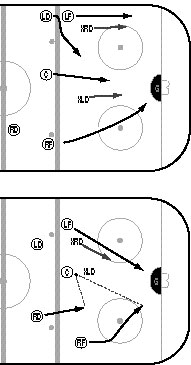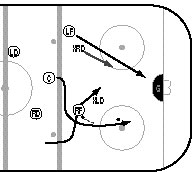 |
| Figure 1 (top) and Figure 2 (bottom). |
Consistently moving the puck over the blue line and into
your offensive zone may be easy for your team or it may be the weak link in
your offensive attack. For most teams, it really depends on the team that you
are playing, and more specifically the ability of the opposing team�s defensemen
to pressure your attack at the blue line.
If the opposing team�s defense is not aggressive (and continues to move back
into your offensive zone as you attack), then this article may not be for you.
But what happens when you are playing a team that is very solid defensively?
Not only can they muck things up while you are bringing the puck through the
neutral zone, their defensemen are good at standing you up at the blue line.
If this is the case, then the tips in this article should be just what the coach
ordered.
Also, even though most roller hockey games are played without blue lines,
the concepts in this article can be applied to develop a more potent offensive
attack for your inline game as well.
Wayne Gretzky was undoubtedly one of the best players at being able to consistently
bring the puck over the blue line and establish a presence in the offensive
zone. Rarely did he put on the burst of speed to try and out-duel a defenseman;
he prefered to outwit, out skate, and outplay the opposing defense ... and very
seldom did he lose. Three techniques that your team can use to gain the blue
line include down-the-boards, up-the-middle, and walkin�-the-line.
Down-the-Boards
This blue line penetration technique (Figure 1) is really a drop pass to a
trailing defenseman (LD) who is doing a good job of supporting the puck carrier
(LF). As LF penetrates the blue line, the opposing defenseman XRD begins to
put pressure on him. LF puts on a burst of speed, drops the puck to LD, and
acts as a decoy to take XRD out of the play.
LD gains control of the puck and cuts toward the net to get into a good scoring
position. LD then has three options; to skate with, pass, or shoot the puck.
The center (C) and the right winger (RW) need to make sure that they support
LD for either choice.
Up-the-Middle
A great penetration play (Figure 2) to use when your team has good speed is
to have your center (C) carry the puck over the blue line and stop just as he
crosses the line (as long a you don�t have an opponent close on your tail).
This forces the opposing defensemen to make a choice: either continue to skate
back toward their net (covering the wingers) or have one defenseman stop with
the center. If the defenseman (XLD) stops, RD and RF are immediately open for
a pass and a good scoring opportunity. If both defensemen continue to skate
toward their net, C can move again toward the net or can dish the puck off to
RD for a great scoring opportunity.
Walkin�-the-Line
 |
| Figure 3 |
This play is excellent for two reasons; it gets the puck across the blue line,
and you can usually develop a 3-on-2 into a 2-on-1. As RF skates with the puck
across the blue line, he cuts parallel with the blue line toward the center
of the rink (usually one of the defensemen will stay with RF�XLD in this case).
The center (C) reads the play and supports RF through position exchanging (taking
RFs position on the right side of the rink). If the opposing defenseman (XLD)
covers RF, RF dishes the puck off to C and C can move in on a great scoring
opportunity. LF can act as a decoy or can receive a pass for a quick one-timer.
If you can get the puck through the neutral zone successfully, you can choose
one of these three blue line penetration techniques to effectively penetrate
the blue line and gain a stronghold in your offensive zone.
Greg Siller, author of the book Roller Hockey: Skills And Strategies For
Winning On Wheels, can be contacted at via his web site at www.prolearning.com.